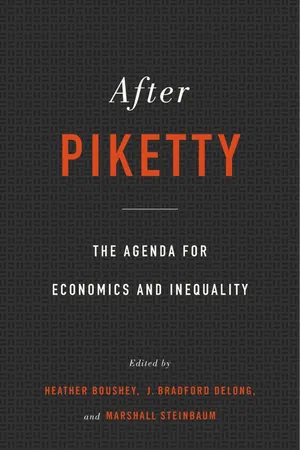
After Piketty
The Agenda for Economics and Inequality
- English
- ePUB (mobile friendly)
- Available on iOS & Android
After Piketty
The Agenda for Economics and Inequality
About this book
A Foreign Affairs Best Book of the Year
"An intellectual excursion of a kind rarely offered by modern economics."
—Foreign Affairs
Thomas Piketty's Capital in the Twenty-First Century is the most widely discussed work of economics in recent years. But are its analyses of inequality and economic growth on target? Where should researchers go from there in exploring the ideas Piketty pushed to the forefront of global conversation? A cast of leading economists and other social scientists—including Emmanuel Saez, Branko Milanovic, Laura Tyson, and Michael Spence—tackle these questions in dialogue with Piketty.
"A fantastic introduction to Piketty's main argument in Capital, and to some of the main criticisms, including doubt that his key equation…showing that returns on capital grow faster than the economy—will hold true in the long run."
—Nature
"Piketty's work…laid bare just how ill-equipped our existing frameworks are for understanding, predicting, and changing inequality. This extraordinary collection shows that our most nimble social scientists are responding to the challenge."
—Justin Wolfers, University of Michigan
Frequently asked questions
- Essential is ideal for learners and professionals who enjoy exploring a wide range of subjects. Access the Essential Library with 800,000+ trusted titles and best-sellers across business, personal growth, and the humanities. Includes unlimited reading time and Standard Read Aloud voice.
- Complete: Perfect for advanced learners and researchers needing full, unrestricted access. Unlock 1.4M+ books across hundreds of subjects, including academic and specialized titles. The Complete Plan also includes advanced features like Premium Read Aloud and Research Assistant.
Please note we cannot support devices running on iOS 13 and Android 7 or earlier. Learn more about using the app.
Information
[ III ]
DIMENSIONS OF INEQUALITY
TEN
Increasing Capital Income Share and Its Effect on Personal Income Inequality
Methodological Contributions of Piketty’s Capital
Table of contents
- Cover
- Title Page
- Copyright
- Dedication
- Contents
- Introduction: Capital in the Twenty-First Century, Three Years Later
- I. Reception
- II. Conceptions of Capital
- III. Dimensions of Inequality
- IV. The Political Economy of Capital and Capitalism
- V. Piketty Responds
- Notes
- Acknowledgments
- Index